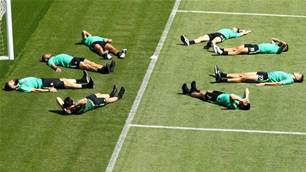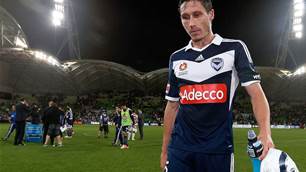With more experience at 21 than most players have in a career, Socceroo Mark Milligan has a maturity beyond his years. And the World Cup was just the start...
Page 3 of 3 | Single page
Do you see your selection to the World Cup squad as a way of grooming you as a future leader of the Australian team? Giving you experience of what it’s like to be in the biggest football tournament in the world.
I can see that and I want to be playing for my country for a long time. I love wearing the green and gold and I think he was definitely taking along a few younger players to give us the experience that we can take into the future. The younger players need to know what it’s like to be at big tournaments and go into big games with confidence. And then when you do get a regular run in the team and play in big games then it’s not a shock to the system. I think he was trying to fill that footballing gap between a lot of us playing in the A-League and then stepping up to play in world class competition.
How important is continuity in the Australian game, having all the teams playing the same style of football?
All the good footballing nations do this. If you’re brought up in Holland, no matter what age you are, all the teams have the same style of play, they like getting it wide and attacking. Over here I don’t think we’ve had so much of that in the past with different coaches and philosophies; nothing that if you went a goal down, this was how you were supposed to play. You can’t always rely on individual brilliance, you need a structure. So when you’re all playing under the same structure or system, it’s easier for player like myself and Spase Dilevski and Stuey Musiliak to make that step up to from U20s or U23s to the national team if you know your job and the team’s job.
Do you see the style of football changing in the future?
I think we’re still going to play the same brand of football you saw from us in the World Cup. I know Ange [Postecoglou] at the U20s is concentrating on that with the players coming through there and with the U23s as well. We all love a passing game and all the players picked can pass the ball. I think we’re proving we can do that and we just don’t hit the ball long and hope someone will get on the end of it. And that’s at all levels. The U20s have had a good tour recently, there’s some good players coming through and we’re all on the same wavelength.
This two Australian team structure – one from the A-league and one from the European-based players – it’s even more important...
Yeah, if everyone’s playing the same sort of football at the same level, it makes it easier to bring the team together. We don’t get a lot of opportunities to play together as a national team but if all the national players, a group of forty or so who play in both Europe and Australia are all playing the same style of international football, they don’t have to go through that two or three days of getting to know each other’s thinking. It’s already there. I think that’s half the battle just knowing what the guy next to you is thinking without having to ask him. If I get the ball on the right, I know where my centre midfielder is going to going to be all the time.
With two teams, is it quite hard as a young player to know you’re not really going to get a big run in the team as the European players are always there?
It is hard but it is good that we have more options, that players who are playing in Australia are getting a chance to prove themselves at international level. In a year’s time when we’re heading into the Asian Cup we will be grateful there were so many players to choose from as it will have brought the general level of the players up. It goes back to having a lot of players who have experienced playing in the system before. It’s easier to put a player in who’s been there and experienced it before. It’s easier to teach someone something in a day than having them start from scratch.
I can see that and I want to be playing for my country for a long time. I love wearing the green and gold and I think he was definitely taking along a few younger players to give us the experience that we can take into the future. The younger players need to know what it’s like to be at big tournaments and go into big games with confidence. And then when you do get a regular run in the team and play in big games then it’s not a shock to the system. I think he was trying to fill that footballing gap between a lot of us playing in the A-League and then stepping up to play in world class competition.
How important is continuity in the Australian game, having all the teams playing the same style of football?
All the good footballing nations do this. If you’re brought up in Holland, no matter what age you are, all the teams have the same style of play, they like getting it wide and attacking. Over here I don’t think we’ve had so much of that in the past with different coaches and philosophies; nothing that if you went a goal down, this was how you were supposed to play. You can’t always rely on individual brilliance, you need a structure. So when you’re all playing under the same structure or system, it’s easier for player like myself and Spase Dilevski and Stuey Musiliak to make that step up to from U20s or U23s to the national team if you know your job and the team’s job.
Do you see the style of football changing in the future?
I think we’re still going to play the same brand of football you saw from us in the World Cup. I know Ange [Postecoglou] at the U20s is concentrating on that with the players coming through there and with the U23s as well. We all love a passing game and all the players picked can pass the ball. I think we’re proving we can do that and we just don’t hit the ball long and hope someone will get on the end of it. And that’s at all levels. The U20s have had a good tour recently, there’s some good players coming through and we’re all on the same wavelength.
 |
| Millsy sees himsel on the big screen in the green and gold |
This two Australian team structure – one from the A-league and one from the European-based players – it’s even more important...
Yeah, if everyone’s playing the same sort of football at the same level, it makes it easier to bring the team together. We don’t get a lot of opportunities to play together as a national team but if all the national players, a group of forty or so who play in both Europe and Australia are all playing the same style of international football, they don’t have to go through that two or three days of getting to know each other’s thinking. It’s already there. I think that’s half the battle just knowing what the guy next to you is thinking without having to ask him. If I get the ball on the right, I know where my centre midfielder is going to going to be all the time.
With two teams, is it quite hard as a young player to know you’re not really going to get a big run in the team as the European players are always there?
It is hard but it is good that we have more options, that players who are playing in Australia are getting a chance to prove themselves at international level. In a year’s time when we’re heading into the Asian Cup we will be grateful there were so many players to choose from as it will have brought the general level of the players up. It goes back to having a lot of players who have experienced playing in the system before. It’s easier to put a player in who’s been there and experienced it before. It’s easier to teach someone something in a day than having them start from scratch.
Related Articles

Milligan: We just fell short...

What would you be doing if you weren't at the World Cup, lads?













